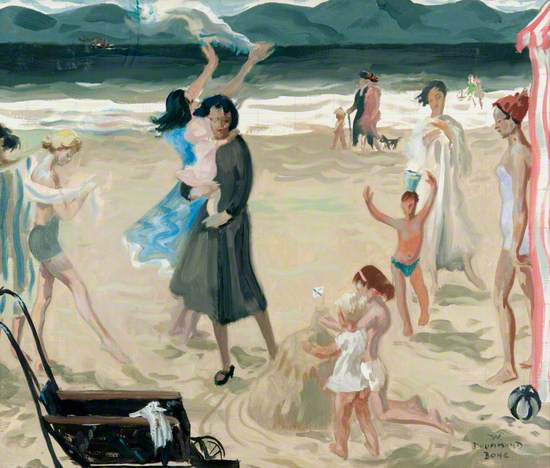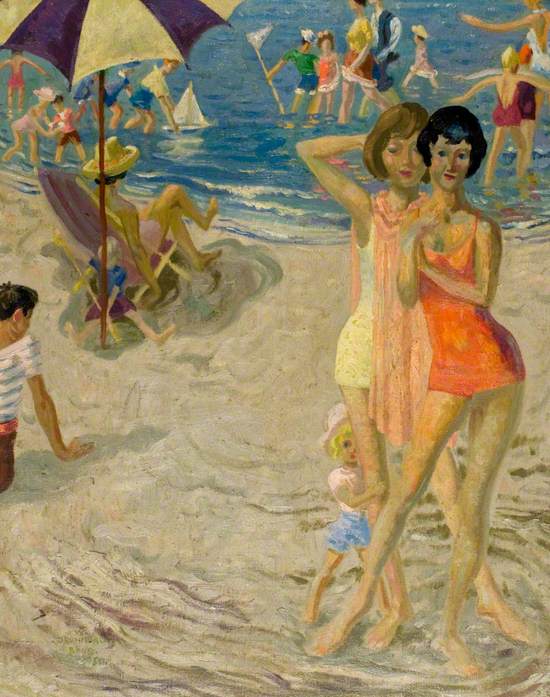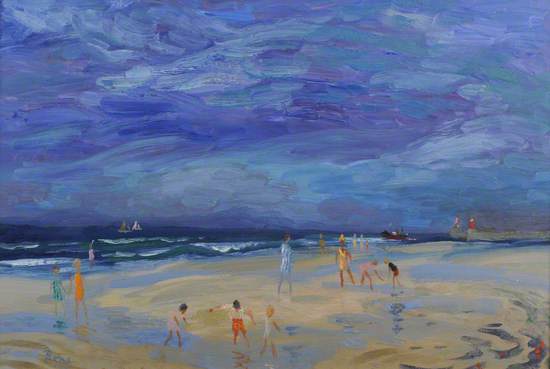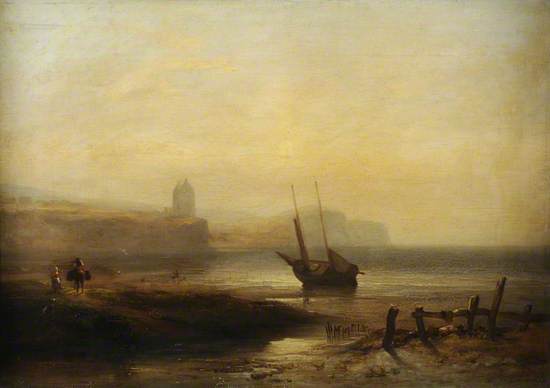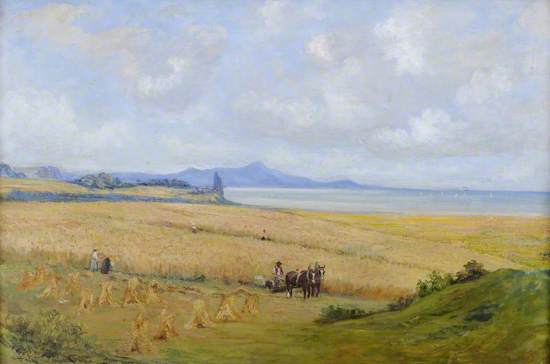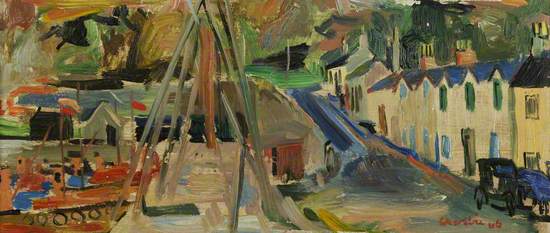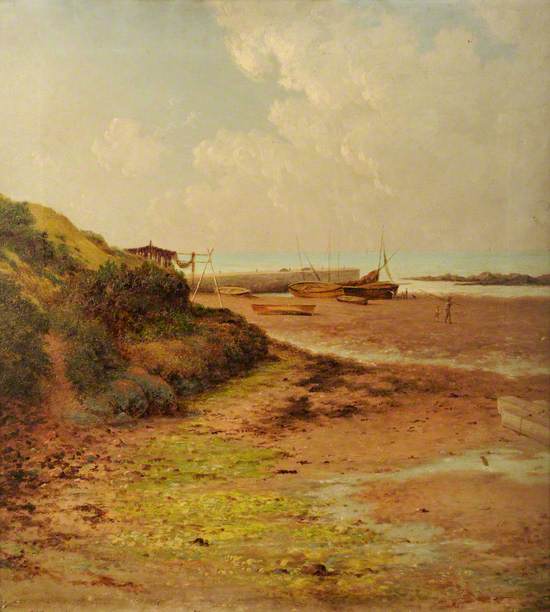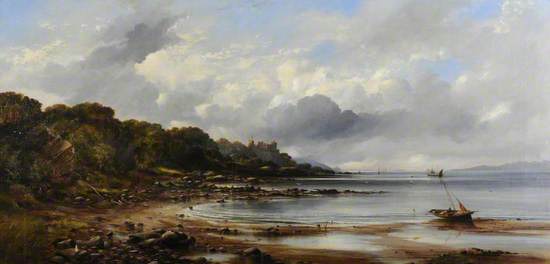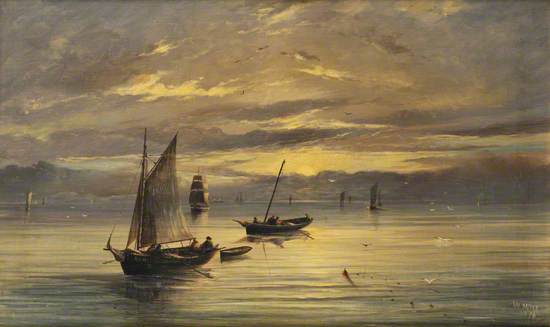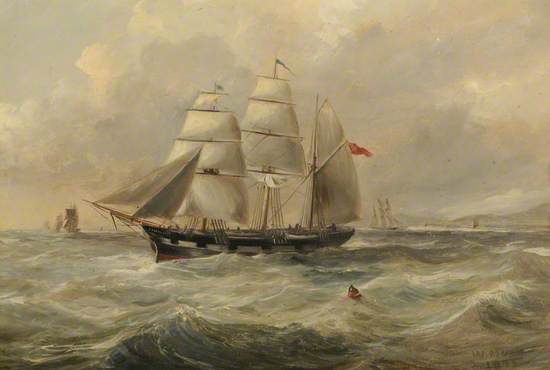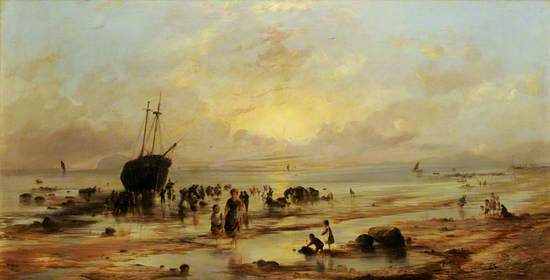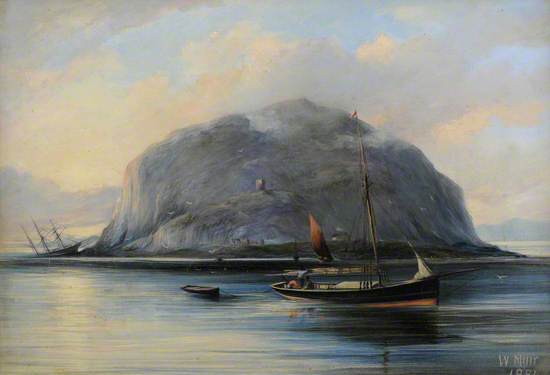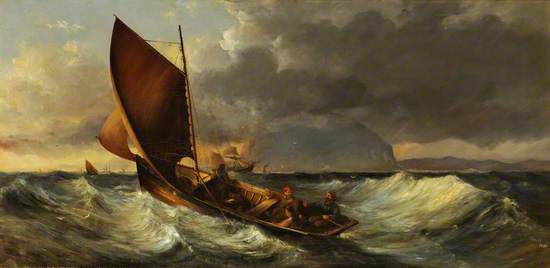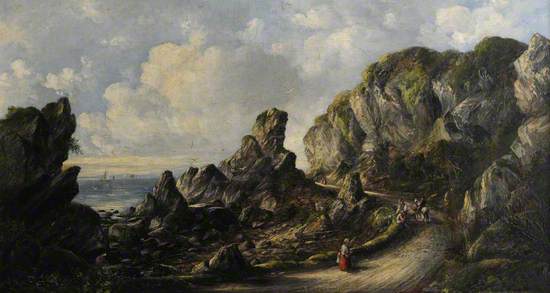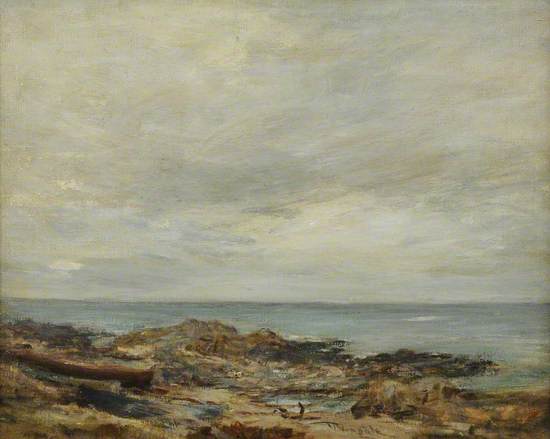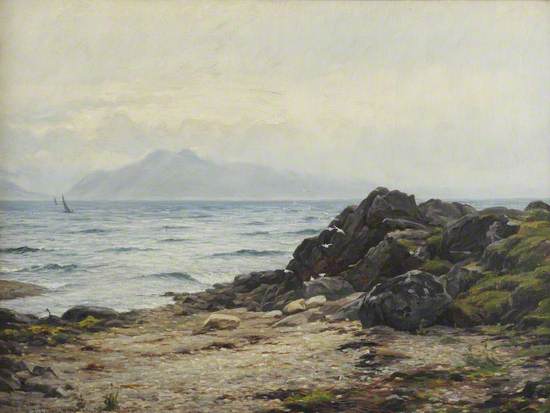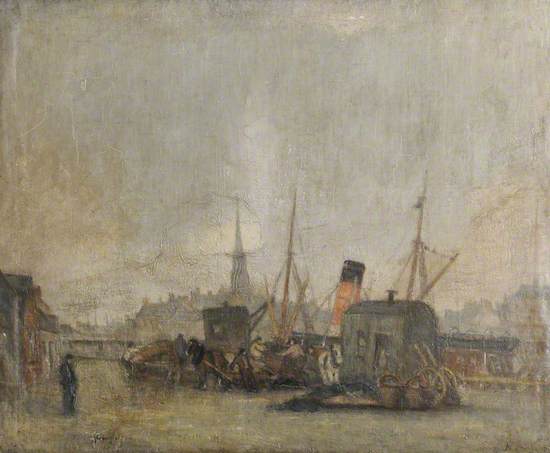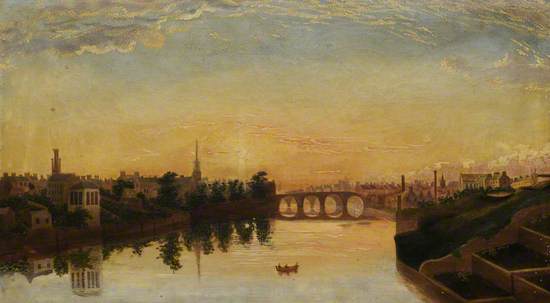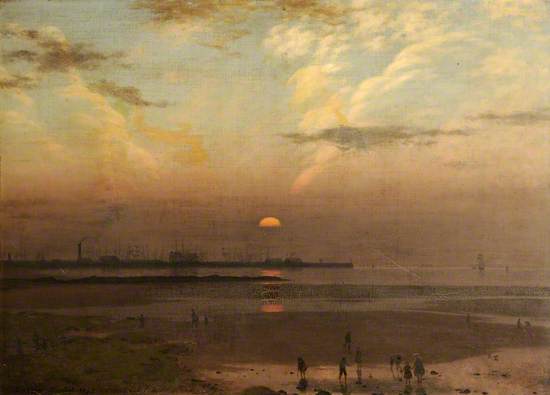This exhibition offers a meander along the South Ayrshire Coast, featuring works from the South Ayrshire Council Fine Art collection, with captions researched and created by local members of the U3A Working Art Appreciation Group.
We started this exhibition just before lockdown, and purposefully limited our choice to paintings held in a particular store. During lockdown, we were further restricted, now only able to include works from our list that are on the Art UK website. We embraced this (even bent a few rules along the way!). The resultant selection shines a spotlight on lesser known works that deserve to be enjoyed!
Visit South Ayrshire for the lovely beaches? Stay for the sunsets!
Ayr Low Green
Bryden was born in Coylton. After a period working in the office of Hunter & Morris, Architects, Ayr, he moved to London where he stayed for 15 years studying at the RSA and the Royal Academy, and making a living from commissions and teaching art.
Prolific, Bryden produced paintings, engravings and sculptures. His bronze portraits of William Wallace and Robert the Bruce are in Ayr Town Hall; his carved wooded figures are part of the South Ayrshire Council collections. He published 3 volumes of etchings illustrating castles in the County of Ayrshire, and is also responsible for the Coylton War Memorial. In 1899 he was granted the title of Royal Engraver.
The Pleasure Beach
William Bone was born in Ayr. His early interest in art was nurtured by his uncle - acclaimed artist Sir Muirhead Bone, who was the first official war artist during WWI - and who continued to mentor William throughout his life.
William studied at Glasgow School of Art between 1928-1931, winning a travelling scholarship that took him to Europe. Best known for his WWII watercolours, he also painted landscapes and figurative drawings.
William Drummond Bone (1907–1979)
Acrylic (?) on canvas
H 76.7 x W 55.3 cm
South Ayrshire Council
.
A Breezy Day by the Sea
There are two works featured on the Art UK website by Bone, both in the collection of Dundee Art Galleries and Museum Collections,and which appear to feature Ayr.
Evocative of their time, they echo the tone and design of the poster design held by South Ayrshire Council.
Although the titles of the work don’t record that they are of Ayr – the mountains in the background of ‘A Breezy Day’ seem to suggest the Isle of Arran. The weather feels familiar too!
William Drummond Bone (1907–1979)
Oil on canvas
H 62 x W 74.5 cm
Dundee Art Galleries and Museums Collection (Dundee City Council)
.
Seaside, on loan from a private collection.
This painting by Bone captures the holiday spirit, in the same poster-style. Again whilst not identified as Ayr, as a collection seen together, there are synergies between these works.
William Drummond Bone (1907–1979)
Oil on canvas
H 75 x W 59.5 cm
Dundee Art Galleries and Museums Collection (Dundee City Council)
Ayr Shore
Unmistakably and titled Ayr, in this image painted by William Bone in 1975 we see a more exuberant use of colour and brush work, as if to capture the excitement of the children at play and the energy of the waves.
On the right, the harbour walls and lighthouse to the north of the beach can be seen. Small family groups enjoy the warm pools left by the receding tide.
Many visitors to Ayr will have fond memories of days spent on the sands. In 1975 there were still donkey rides available, and occasional Punch and Judy shows to add to the delight of a day at the seaside - although they don’t appear in this painting.
William Drummond Bone (1907–1979)
Oil on board
H 49.7 x W 75.4 cm
South Ayrshire Council
Fisherfolk
Now, we head down the South Ayrshire coast, taking the shore line, as these fisherfolk do.
Robert McGregor RSA was a painter of landscapes, seascapes, portraits and genre, particularly of fishermen, shepherds, crofters, pedlars, and farm labourers.
Born in Bradford, McGregor lived in Edinburgh, exhibiting at RSA aged 26 in 1873 until 1916. Yearly visits to Normandy and Holland and the teachings of Bastien-LePage and Millet influenced him, choosing subtle light over full colour, combining study of tone with capable draughtsmanship.
He used the same family as models in many paintings, here identifying the affinity between young and old as they go about their labours together on the fringes of the sea. The narrative, without being dramatic, records the innocence and simplicity of a traditional way of life.
McGregor was elected to the RSA in 1889, exhibited at the Royal Academy and the Royal Glasgow Institute of the Fine Arts. His work is represented in galleries throughout the world.
Greenan Castle, Ayrshire
Born at Cowden, near Dalkeith, Midlothian, Crawford first exhibited in the Royal Institution in 1831. He visited the Netherlands several times, studying closely the Dutch Masters whose influence in forming his picturesque style can be clearly seen in nearly all that he painted.
Scotland inspired him, and in 1848 he produced his first great picture ‘Eyemouth Harbour’, which he rapidly followed up with other high-quality work, establishing himself as one of the greatest masters of landscape-painting in Scotland. Of the Old School tradition, he was less realistic in detail, but wider in its grasp, striving to give the impression of nature rather than the literal truth.
Edmund Thornton Crawford (1806–1885)
Oil on canvas
H 45.8 x W 64.9 cm
South Ayrshire Council
Greenan
Greenan Castle, just South of Ayr, is a picturesque ruin, much favoured by artists and sketchers. A four-storey tower of late C16th appearance, it perches precariously on top of a cliff. The castle ruins were stabilised in 1899, after this painting was completed.
Thompson was born in Perth in 1853. In the 1891 and 1901 census he is listed as being an Art and Drawing teacher, living at Academy Street, Ayr with his wife Annie and their three children.
First Day Dunure
Born in Hankow, China to Scottish parents, Crosbie moved to Glasgow in 1926. He attended Glasgow Academy and Glasgow School of Art 1932 -1934, then travelled in Europe on a Haldane Travelling Scholarship. From 1937 -1939 he lived in Paris, studying under Léger and Maillol.
In the 1940s -1950s Crosbie was making his name as a mural painter. This painting then was possibly completed whilst on holiday – his daughter Pauline was born in 1947.
The bold brush strokes and scattered use of bright splashes of Cerulean Blue give the unpeopled scene a vibrant sense of expectation.
Crosbie is among the finest and most singular Scottish painters of the C20th and his work is held by institutions throughout the UK.
William Crosbie (1915–1999)
Oil on board
H 12.8 x W 29.7 cm
South Ayrshire Council
.
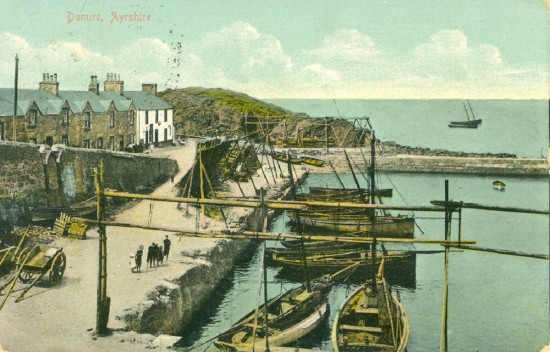
This old photograph records a scene similar to one Crosbie observed. He depicts the white-washed fishermen’s cottages, with an Austin car in front of the Dunure Inn. The triangular shaped gable windows echo the central structures in his composition.
Dunure, Ayrshire
.
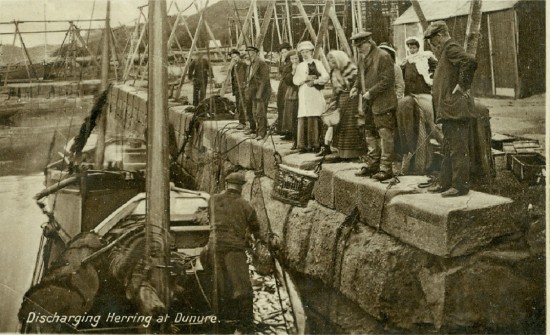
The huge wooden drying racks that dominated the quayside can also be seen in this old photograph.
In the 1960s, Dunure was the home base for 30 fishing vessels of up to 50ft in length. However, as boats became larger and, in particular, demanded a deeper depth of water, the limitations of the harbour became obvious and the fishing fleet declined.
Discharging Herring at Dunure
.
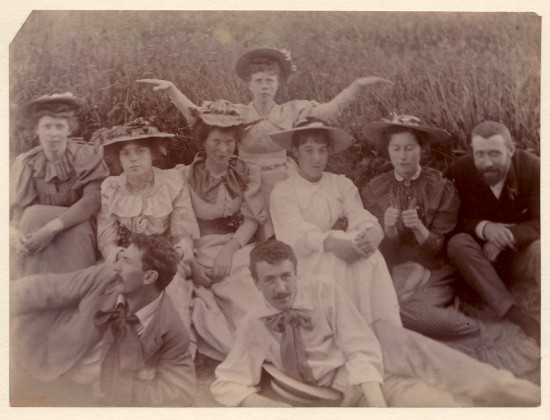
The Immortals at Dunure
Many artists have found peace and inspiration at Dunure. Here, we see the famous 'Immortals': Frances Macdonald, Margaret Macdonald, Katherine Cameron, Janet Aitken, Agnes Raeburn, Jessie Keppie, John Keppie, (front row from the left) Charles Rennie Mackintosh, Herbert MacNair, c. 1893.
Dunure has enjoyed a recent revival, as it was used as a location in the popular ‘Outlander’ series - transformed into the port where Jamie and Claire meet Jared, and board the Artemis for their journey to Jamaica. Some of the local citizenry featured as extras!
The Immortals at Dunure, image courtesy The Glasgow School of Art
Maidens
This local scene at Maidens depicts the little harbour at high tide on a fine day, where boats are drawn up to the shore and the nets are drying on the fishing boats' return to home.
The sea is calm, as are the adults and children who quietly work together in a scene of shared activity.
Balance and harmony is suggested in the even horizontal division of sky and land by the sea; from the diagonal line separating the hilly green foreground with its warmer earthy colours, to the cool tones of the blue sea and white puffy clouds.
The viewer is drawn into the tranquil scene by lovely perspective to enjoy the many textures and touches of light.
Rocky Coast Scene in Rain
Armstrong was an amateur artist from Ayr, active 1895 -1900. He exhibited four times at the Royal Glasgow Institute of the Fine Arts.The stretch of coastline is not identified, but could the rock formations observed be to the south of Dunure?
A chilly atmosphere is suggested by the use of cool colours in a limited palette of greys, white, and green with warmer reflected light on the sand at the water's edge. The heavy rocks provide texture, their contours lit to show their wet base, and frame for the waves.
The rhythmic rollercoaster movement of the waves provides interest; foam suggests the slope of the shore where the seabirds gather. The horizon emphasizes the sea. The sky is very subdued suggesting rain clouds and wind. A dreich day!
Walter Armstrong
Oil on canvas
H 54.4 x W 89.4 cm
South Ayrshire Council
Culzean Castle and Bay
Culzean Castle was once the home of David Kennedy, 10th Earl of Cassillis – a man who was keen to impress with his wealth and status. Opulent to the extreme, the park is planted with conifers and beech, sculpted around miles of sandy coastline dotted with caves, and finished off with a Swan Pond, an ice house, flamboyant formal gardens and fruit-filled glasshouses.
Perched on the cliffs, it was created by architect Robert Adam between 1777 - 1792 on the site of an older stone tower house. It is filled to the turrets with treasures that tell the stories of the people who lived here.
Directly beneath and accessible from the beach, there are large caves, that contain evidence that people lived there in Neolithic times.
William Muir (1828–1910)
Oil on canvas
H 59.1 x W 120.4 cm
South Ayrshire Council
Girvan
Girvan, tucked in between the sea and the hills has a stunning setting. It commands a magnificent view to sea of the North Coast of Ireland, Ailsa Craig, the Isle of Arran and the Mull of Kintyre.
The Stumpy Tower or “Auld Stumpy”, was at the time of this painting, Girvan's tolbooth (courthouse and jail), built between 1825-27. Situated on Knockcushan Street, it is a B-listed building 29m (95 feet) high and incorporates a clock. The buildings around the tower were demolished in 1908 and the tower was incorporated into the McMaster Hall, which opened in 1911.
Girvan Harbour, 1900
Here, Girvan's picturesque harbour has a subdued and gloomy atmosphere, with a single pop of brightness represented by the central white property breaking the row of brown and grey buildings.
The boats are tied up; they too are brown and grey, and there is no activity on this quiet dull day. The backdrop of the grassy hills, bereft of trees, gives no clues to the season but the viewer may sense the chill of winter, perhaps reflecting the darker fortunes of a once bustling and busy harbour as the seated fisherman await a chance to go to sea.
This work is clearly dated 1900 beside Caldon's signature.
William Muir was born in Ayr on 18th March 1828, moving to Girvan when he was married in 1858. He and his wife Susan Mackay lived at 3 Dalrymple Street. William was a master baker to trade and his creative body of art work contains mainly local topographical studies of the Girvan area.
After he retired, Muir and his wife left Girvan in 1903 to join their eldest son, a Glasgow University educated G.P., in Wynyard, Tasmania, where he continued to paint. William died in 1910 and is buried in Wynyard.
In 1915, benefactor Thomas Davidson made a gift of 25 paintings by William Muir to Girvan Town Council. These were hung in the McMaster Hall until the fire of 1939, after which they exhibited throughout the town.
Herring Fishing at Girvan
In the 1760s, considerable herring fishing took place at the mouth of the River Girvan, very near the town, which continued for two or three years, bringing wealth and causing a sudden and considerable extension to the town.
William Muir (1828–1910)
Oil on canvas
H 74.4 x W 120.4 cm
South Ayrshire Council
Returning from Fishing, Girvan
In the 1790s the waters around the Bay of Girvan were known to abound with whitefish (cod, ling, haddock, whiting, mackerel, sole, flounders, turbots) and lobster. Salmon were caught by net and coble, mostly in June. Some salmon were sold on the spot, but a greater part of the catch was carried by hand to Kilmarnock or Glasgow.
William Muir (1828–1910)
Oil on canvas
H 39.4 x W 65 cm
South Ayrshire Council
The Barque 'Camelot'
A barque is a sailing ship, typically with three masts, in which the foremast and mainmast are square rigged and the mizzenmast is rigged fore and aft.
Where do you think the Camelot was coming from and going to?
What do you think she was carrying?
William Muir (1828–1910)
Oil on card
H 22.8 x W 34 cm
South Ayrshire Council
The Sands, Vessels on the Rocks
A large ship sits on the sands at low tide, in calm weather, Ailsa Craig in the distance. There are many people, of all ages - but what are they doing? Are they disembarking from a stranded vessel? Are they at leisure or at work? Are they sight-seeing?
Seaweed was (and is) found in abundance on the shore and was very generally used as manure for crop growing. Are they gathering seaweed?
William Muir (1828–1910)
Oil on canvas
H 59.8 x W 115.6 cm
South Ayrshire Council
The story of Girvan's maritime history is told in much more detail at the McKechnie Institute. Opened in 1889 thanks to the benevolence of local businessmen brothers, Thomas and Robert, The McKechnie Institute is now home to locally found Geology, fossils, natural specimens, and Bronze Age Cinerary Urns dating 2100-1500BC.
Built in the Scottish Baronial style with Renaissance detailing, The McKechnie's architects McKissack & Rowan of Glasgow also designed Girvan’s North Parish Church. The ground floor originally contained a library, reading room and ladies room, with a billiards room and a Librarian’s house on the first floor. There's a Victorian lounge and bedroom for visitors to view.
Ailsa Craig
Ailsa Craig is an island of 99 hectares (240 acres) in the outer Firth of Clyde, 16km (10 miles) West of mainland Scotland rising abruptly from the sea. It is 340m high, with a conical summit and is accessible by boat from Girvan. The island is formed from the plug of an extinct volcano. It is famous for its geology; blue hone granite has long been quarried to make Olympic curling stones.
William Muir (1828–1910)
Oil on canvas
H 29 x W 43 cm
South Ayrshire Council
Squall off Ailsa Craig
In the late C19th Ailsa Craig was home to 29 people, working in the quarries or lighthouse. They exported birds’ feathers too; Ailsa was teeming with seabirds - but when rats arrived, birds could only successfully breed if they nested on inaccessible ledges. Puffins were wiped out and Manx Shearwaters were prevented from colonising the island.
William Muir (1828–1910)
Oil on canvas
H 60 x W 121.4 cm
South Ayrshire Council
Kennedy's Pass
In 1794, Girvan was described as “a port town which lies on the great road between Ayr and Port Patrick.” By 1837, it was noted there were excellent turnpike roads in the parish and that the Glasgow to Portpatrick road ran along the west side of the parish, “with but a little deviation from the coast”. Today, Kennedy’s Pass lies on the A77, South of Girvan, on the way to Lendalfoot.
Here, people are using this great road, by foot and on horseback. The road appears to be dry and well maintained - that may be artistic license! The rocky outcrops were locally called “rotten-rocks or pudding-stone”.
William Muir (1828–1910)
Oil on canvas
H 34.5 x W 65 cm
South Ayrshire Council
The 1837 Statistical Account for the Parish of Girvan states:
“The shore for several miles is bounded by this rock, which in many places assumes a most fantastical appearance. In many instances, mass of it is seen piled upon mass, resting on props so narrow as to make one astonished that they do not lose their balance. They seem indeed as if they had been placed in their current position by the nicest efforts of art.”
Kilbrennan Sound
Wingate was born in Glasgow, and initially worked as a commercial clerk, taking drawing lessons in the early morning. Influenced by Ruskin and the Pre-Raphaelites, he exhibited in 1864 at the Glasgow Fine Art Institute. He left his job and toured Italy in 1867-68, before returning to Hamilton and studying at the Royal Scottish Academy.
Hugh Cameron’s assertion that art “is an affair of feeling" significantly appealed to Wingate; he was also influenced by William McTaggart, resulting in increasingly free and impressionistic landscapes. Both McTaggart and Wingate painted Scotland’s West Coast.
Often misspelled Kilbrennan, this view is from Pirnmill where the hills of the Mull of Kintyre are at their lowest and most uniform.
James Lawton Wingate (1846–1924)
Oil on canvas
H 39.7 x W 49.6 cm
South Ayrshire Council
Misty Day, Sound of Kilbrannon
Another view of Kilbrannan.
Bannatyne was born in Scotland but lived in London. He made his name as a landscape painter and watercolourist. Influenced by the Pre-Raphaelites, he is remembered for his detailed pastoral scenes of the Highlands and Lochs of Scotland.
Living in the Industrial Age, Bannatyne was among many who took advantage of the new railway network, allowing him to seek new and inspirational landscapes, such as North Wales, The Lake District and Scotland.
John James Bannatyne (1836–1911)
Oil on canvas
H 44.3 x W 59.7 cm
South Ayrshire Council
The Industrial Revolution had both an economic and artistic impact. The North of England prospered as mill and factory owners generated a vibrant and strong economy. Many became great patrons of the Arts creating a huge demand for paintings by artists to adorn their new homes and boardrooms.
This virtually empty view of the Kilbrannan Sound shows the Clonaig side, looking back to Arran and Lochranza. Also known as the Clyde Sill, it separates the Isle of Arran from the Ayrshire coast and provides safe passage from the Clyde. An area of interest for marine zoologists, Common and Grey seals abound. Dolphins are less frequently seen in the northern reaches. In 2005 it was listed as having the 2nd highest incidence of basking shark sightings.
After travelling back up the South Ayrshire Coast, we are now back at Ayr Harbour, just in time for some spectacular South Ayrshire Sunsets!
Ayr Harbour
Born in Dundee, self-taught Douglas had his first exhibition aged 16, and his watercolours were included in the Dundee Fine Arts Exhibition of 1877. He moved to Edinburgh, and studied in Paris. In 1891 he married Anna Dawson Douglas - a landscape artist – and they moved to The Ghyll in Applethwaite, near Keswick - the house had belonged to the Wordsworth family.
From Applethwaite, they moved to Rothenburg, Bavaria in 1895, before returning to Edinburgh in 1898. James was elected Member of the Royal Scottish Society of Painters in Watercolours (RSW) in 1900. Much of his art was used for postcards.
By 1907, Douglas was suffering from mental illness. He was struck off the RSW for non-payment of his subscription and died 18th July 1911.
James Douglas (1858–1911) (attributed to)
Oil on board
H 49.3 x W 59.3 cm
South Ayrshire Council
The funnel indicates this vessel might be a ‘puffer’ – the term comes from the puffs of steam and accompanying sound – from early single-stroke steam engines. Built from the 1870s sea-going puffers were an essential link for the coastal communities of Scotland, carrying all manner of cargoes. Their flat-bottomed hulls meant they were able to beach and unload at low tide, not relying on piers.
Ayr Harbour
Born in Glasgow, Bonar Lyon studied at the Glasgow School of Art, the Royal College of Art and in France, Belgium and Holland. He was a painter and etcher of landscapes and figure subjects.
He became Art Master at Irvine Royal Academy, Oban High School, and then at Ayr Academy from 1926 where he became Principal Art Teacher. He became the supervisor of Art in schools with the Ayrshire Education Authority, retiring in 1937.
.
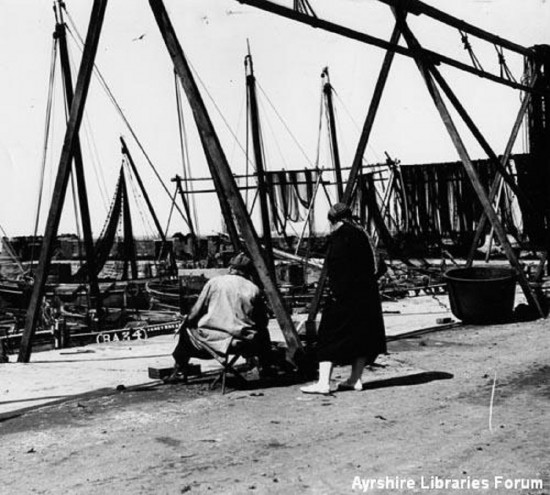
Inspired by the Impressionists, and the Scottish Colourists, Bonar Lyon was often to be found painting ‘en plein air’ at Dunure, where he captured tranquil scenes with a delicate observation of changing colour and light.
Artist Bonar Lyon at Dunure
2020
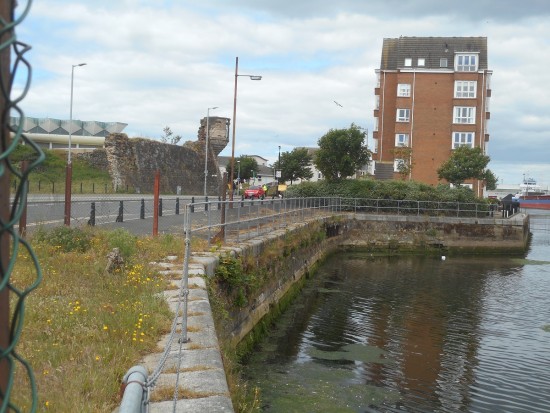
Ayr Harbour is recognisable due to Miller’s Folly - and one of the buildings is most likely the old Harbour Bar. The curved wall can still be seen today.
This view of Ayr Harbour as it is today.
River Ayr from the Cage Walk
With an unknown painter and an unknown date, this artwork poses several questions. We can see it is Ayr, with a view to the setting sun in the West, and a calm, mirror-like river. But when was it painted and by whom? And, did he - or she - give it the title it is known by?
There are clues within the painting as to its date, supposing it is a true record of what was there, rather than a whimsical depiction of past times. The 1st edition Ordnance Survey map of 1855 shows a walkway built on the bridge (on the west side), where the current Cage Walk is, and Ayr Railway Station, which would be just out of the scope of the painting opened in 1857.
The first crossing of the river shown in this painting, is the four spanned Auld Brig. Built 1470 -1525, it was repaired, restored and reopened in 1910. Closely behind is the New Bridge, probably the first New Bridge - demolished and replaced in 1877. However, the painting does not show Turner’s Brig, the cast iron footbridge, which was erected in 1900.
Taking a closer look, you can see the notable landmarks still present in today’s skyline: the Wallace Tower 1832 and Ayr Town Hall 1827, with its magnificent five staged steeple, 225 feet in height. Just to the left of the Town Hall, nearer to the river, the artist paints in detail the gable of the large T-plan Auld Kirk of Ayr of 1654, with its Gothic windows.
To the North, you can glimpse Newton Tower or Steeple 1792-5. Above the steep river bank, is the Roman Catholic St Margaret’s Church, opened in 1827 and the tower of Wallacetown Parish Church, built 1834, with its original tower – which was reduced in height in 1949/50.
The terraced gardens of Content House, built 1799 for Wine Merchant Anthony Whiteside are now demolished.
Content House appears on the 1st Ordnance Survey map of Ayr in 1855, with details of the house, gardens and outbuildings and riverside terraces. The name Content survives in road and street names around this area.
There is evidence too, of how the river is used. A small boat, with three fishermen, is in mid-stream, and it appears that the river is tidal to this point. Nearer the harbour, the masts of a sailing ship can be seen far beyond the Auld and New Bridges, docked along the South bank of the river.
A view from the same position on the Cage Walk today would show, the High Flats of Riverside Place, Turners Brig crossing the river, the River Ayr Walkway, and the houses of Strathayr Place. Turning to one’s right, but behind, would be the buildings of Ayr Fire Station. To the left, on the South side, where there had been mills, now there are more houses, flats and car parks.
BUT WHO WAS THE ARTIST? Art Detectives, get in touch!
Troon, North Beach
We finish with this typical glorious sunset on the West Coast - most of the canvas is given to the drama of the sky. The reflection of the setting sun bounces over the wide sands of the Troon north shore at low tide. In the distance the mass of what became the Ailsa-Troon shipyard looms over the harbour
Born in Falkirk, Stewart lived in Renfrew and Glasgow – by 1901 he is in Kensington with his family of 3 daughters, all of whom went onto careers as illustrators. He made his living as a successful copyist; his work is distributed throughout the UK.
He is noted in the Dictionary of Scottish Artists as a portrait, landscape and coastal painter – in fact, this landscape of Troon appears to be the only coastal painting in public ownership.
Malcolm Stewart (1829–1916)
Oil on canvas
H 59.4 x W 90.2 cm
South Ayrshire Council
By the late 1800s Troon was among the top 10 coal ports in Britain. The shipyard opened in 1860; a lifeboat station in 1871. The shipyard ceased to build ships in 2000.
The figures in the foreground may well be taking the opportunity of the low tide to harvest shellfish. Today razor shells can be picked from this beach in season.
Thank you for joining us on this tour 'Doon the Watter'!
We especially want to thank Helena Burgoyne, Joy Gladstone, Helen McEvoy, Margery MacNicol and Moira Whalen - all members of U3A Ayr, Art Appreciation Group.
Thanks also to:
Alex Boyd and the Arran Community Forum
The Glasgow School of Art
South Ayrshire Libraries
Dundee Art Galleries and Museums
Explore artists in this Curation
View all 16-
 William Crosbie (1915–1999)
William Crosbie (1915–1999) -
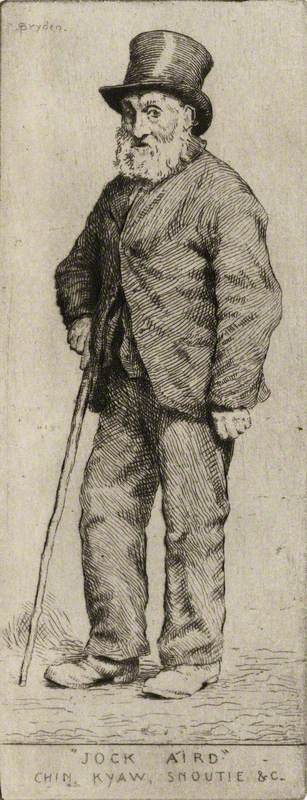 Robert Bryden (1865–1939)
Robert Bryden (1865–1939) -
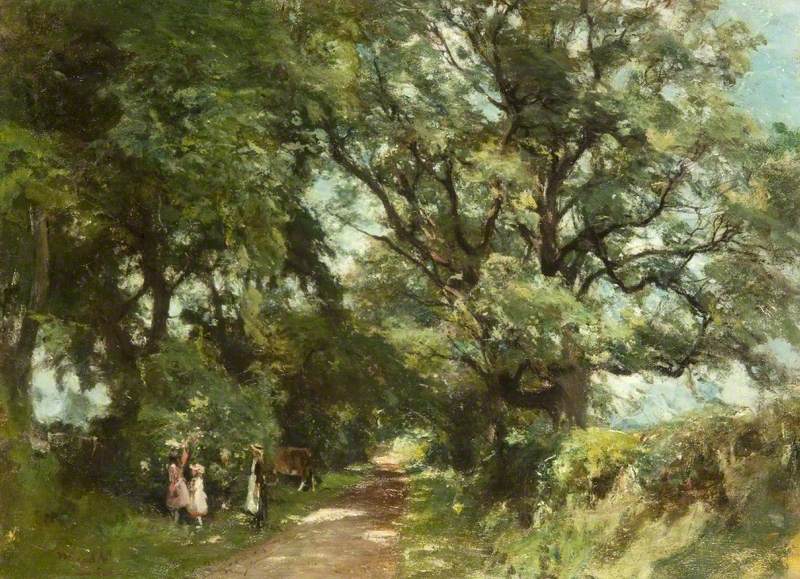 James Lawton Wingate (1846–1924)
James Lawton Wingate (1846–1924) -
 Malcolm Stewart (1829–1916)
Malcolm Stewart (1829–1916) -
 James Douglas (1858–1911)
James Douglas (1858–1911) -
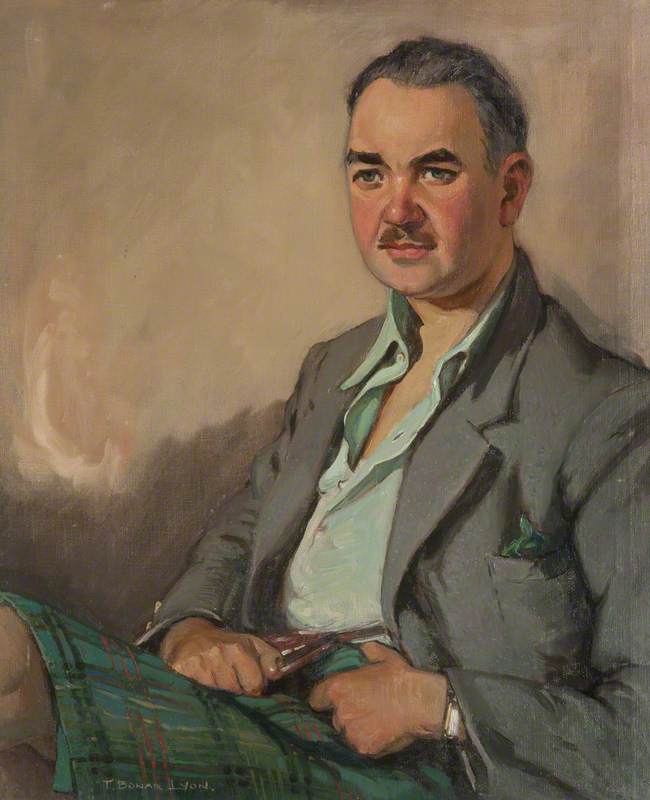 Thomas Bonar Lyon (1873–1955)
Thomas Bonar Lyon (1873–1955) -
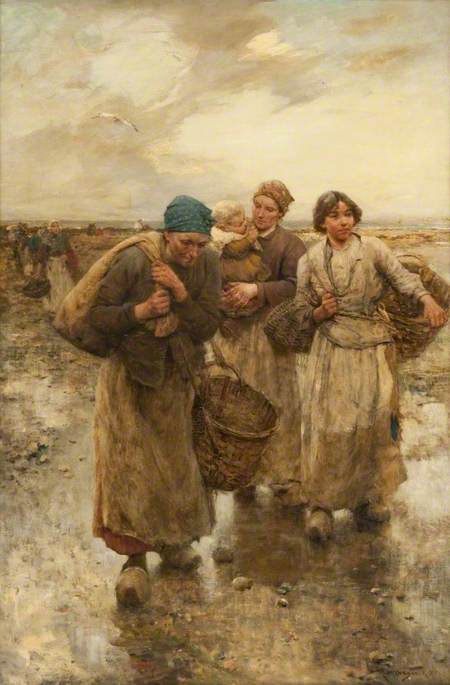 Robert McGregor (1847–1922)
Robert McGregor (1847–1922) -
 John James Bannatyne (1836–1911)
John James Bannatyne (1836–1911) -
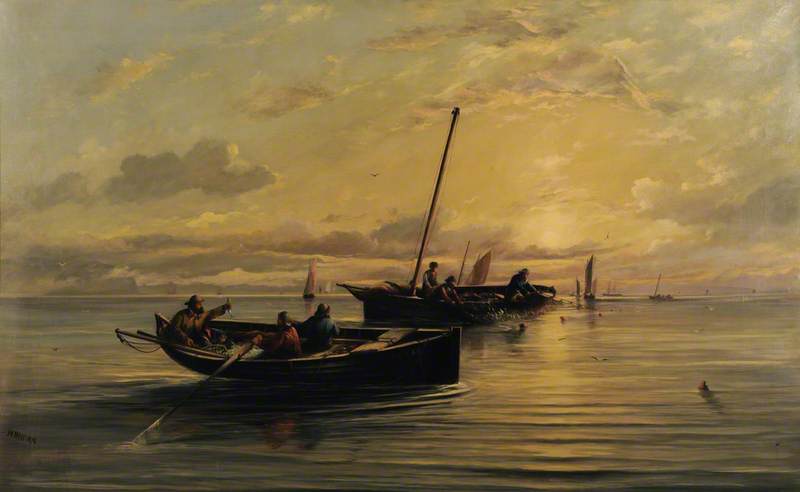 William Muir (1828–1910)
William Muir (1828–1910) -
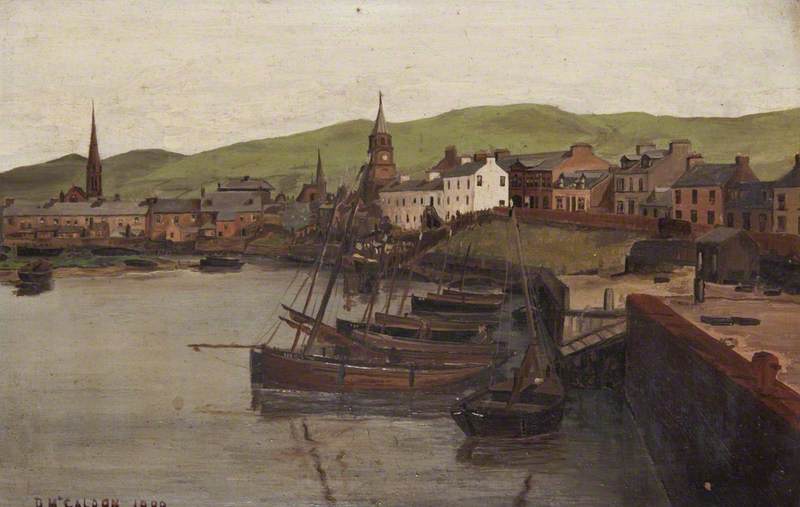 D. M. Caldon
D. M. Caldon - View all 16


